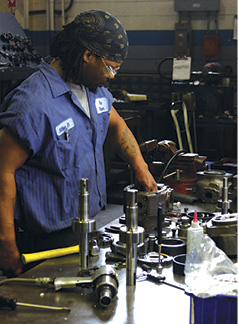When to Replace a Pump
 A frequent question in fluid power is
A frequent question in fluid power is
“When should I replace my pump?”
The answer is
“It depends.”
It depends on a multitude of factors, conditions, age, duty cycle, and performance, etc. There are, however, key indicators that point to a pump’s impending demise, and when detected early, they can mitigate the damages.
Leaking
The most common form of pump failure is the simple leak. There are two basic types of leaks – external and internal:
External leakage is easy to spot; fluid can be weeping or flowing to the outside of a pump, and it usually collects into a puddle. This can be easy to spot with a clean environment. However, poor housekeeping can make the small drip from a leaking seal difficult to spot. When there are puddles and grime, a small leak may go unnoticed.
Internal leakage, on the other hand, cannot be spotted visually. Fluid slipping over vanes or the rotating group of a worn pump will produce heat. This inefficiency will not be seen visually, but can be felt or measured in the form of system heat. All leakage compromises system performance in the form of flow. With less fluid/flow doing the work, the cycle time/performance suffers with slower response.
Performance
Cycle time in a hydraulic system is a sure way to reveal declining system (pump) performance. There is a simple method for testing your system performance. This method requires a clear view of the system actuator and a watch with a second hand. While viewing the actuator, note the time for a complete cycle. Note the cycle time when a unit is new, and you will have a baseline to compare with at a later date. (Tip: write the cycle time on the actuator, the reservoir for an industrial system, or frame rail for a mobile application; you won’t have to search for it later.) As cycle time increases, internal fluid leakage is the likely culprit.
Do you think a few seconds added to your cycle won’t matter? Imagine a cylinder with a cycle time of 10 seconds to extend and retract. This same cylinder cycles once a minute (60 times an hour) for two eight-hour shifts (960 times in a day). Add five seconds to the cycle due to component wear. This is a total of 4,800 seconds (80 extra minutes per day) waiting for a cylinder to shift. Simply put, this is 80 minutes wasted a day because of a small internal leak – 80 minutes a day, 5 days a week, at 4 weeks a month, 12 months a year, times $ lost labor cost. A few minutes, twice a month, to check hydraulic cycle time is a small step that can lead to potential savings.
Noise
All hydraulic systems have inherent noises – the whine of an electric motor, revving of a truck motor, the sound of a piston pump at pressure turning 1750 rpm. Then there are the other sounds, such as the grinding noise or the dreaded knocking sound. These other sounds are an indicator that something is amiss. If you cannot have a conversation near a running hydraulic system without straining to be heard, there is an issue with the system.
This noise may be caused by entrained air in the hydraulic fluid. This can be the result of aeration where free air is drawn into the stream of oil, or from cavitation where dissolved gasses are drawn out of the oil.
The most common point of entry for air is the pump’s suction port. Flange ports that aren’t tight, loose hose connections, or a cracked housing on the pump will all allow air in the system. Even a leaking shaft seal has the ability to draw air into the system. Cloudy oil is usually an indicator of aeration. Cavitation is caused by a restriction at the pump’s inlet (suction strainers and inlet hose). This restriction results in a low inlet pressure that causes dissolved air to vaporize as it enters the pump. In either case, the air bubbles implode as they are suddenly pressurized in the pump. The imploding bubbles make a lot of noise. They will cause metal surfaces to erode and pit, filling the system with metal contaminants. Entrained air can degrade fluid to the point where it can fail to provide lubrication to moving components, resulting in overheating and eventual system failure.
All of this noise, banging, and knocking is your system telling you something is wrong!
Heat
How hot is your hydraulic system? Can you safely hold your hand over the pump? It should be warm; it’s moving fluid and doing work. However, if your pump is so hot you cannot briefly touch it, there is likely an issue.
Heat in a system has many detrimental effects; the greatest is on the hydraulic oil. Oil should be maintained near 120°F for the best results and never exceed 150°F. Oil that is above 120°F will oxidize and begin to separate into acids and sludge, which causes corrosion. The sludge can block orifice pathways leading to more heat. This heat generation then leads to a loss of viscosity, and this lower viscosity will cause a greater slippage or internal leakage that creates more heat. It is a vicious cycle (not viscous).
We covered that internal wear/leakage can develop heat; there are other areas, as well. Entrained air is one. When the air trapped in hydraulic fluid is compressed and implodes, all that energy has to go somewhere. It is turned into heat and pumped into the rest of the system only to end up in the reservoir. The reservoir is designed to do more than just hold fluid; it also functions as a heat exchanger by letting oil cool and dissipate heat to the atmosphere through the walls and air circulation. A reservoir not at the correct fluid level may not allow the oil enough time to exchange this heat.
All hydraulic systems generate heat; it’s just the resistance of the fluid flowing through the hose and tubing that will raise temperatures. It’s the extreme (greater than 180°F) temperatures that are lethal to system components.
Using Sense to Save Cents
When is the best time to replace or rebuild a pump? Barring total failure, nothing is going to answer that question better than a well-managed maintenance program and historical data. Nonetheless, observation using your senses can be an excellent predictor for your system.
- Sight: How long is cycle time, and how does it compare to new? What is the fluid condition?
- Sound: How loud is your system? Are there abnormal sounds?
- Touch: How warm is the system running?
- Smell: Does the fluid have a burnt odor?
- Taste: Don’t even think about it!
Are these red flags starting to pop up in your system? Is cycle time creeping up? It may be time to start planning to replace or rebuild your pump. Do you have a spare unit in inventory? Now is the time to verify model codes and confirm that all system components are working properly. Note: If your system is at the stage that the pump needs to be replaced, so do the filters! Don’t install a new pump with dirty oil and filters. Install the new unit into your system, and after adjustment, record the cycle time and monitor periodically.
This paper does not intend to cover all potential causes of failure; there are many, and they are varied. It assumes that mechanical issues, such as pump and prime mover alignment, are correct; system pressure is properly maintained; and pump was filled with fluid prior to start up. This information is provided as a guideline to help diagnose impending pump issues.








Thank you Scott, excellent article!